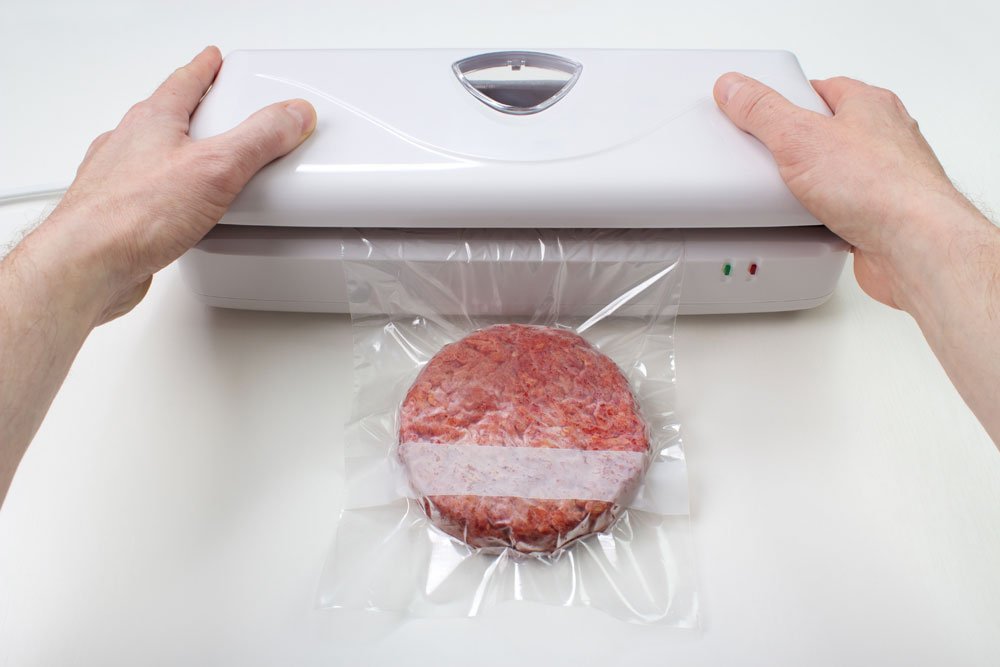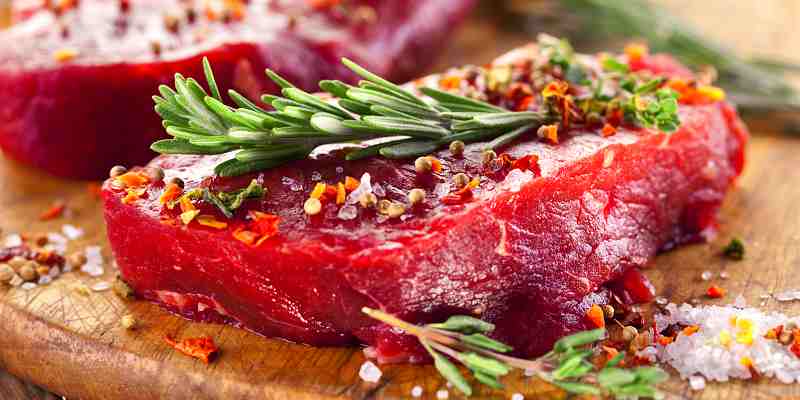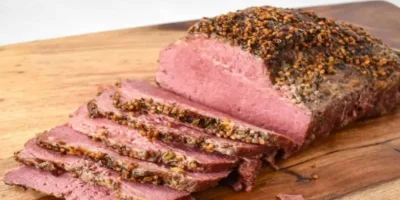How do you freeze and thaw meat correctly? Our guide outlines everything you need to know to get the best result from every type of meat.
Find more food guides, tips and advice
If you store fresh meat in the refrigerator, it can spoil quickly. It stays in the freezer for a significantly longer time if you follow these instructions to freeze and thaw meat correctly.
Which meat can be frozen well?
The ideal prerequisite for freezing meat is that it is raw and fresh. The freshness of meat can be recognized by some distinctive features:
| attribute | Explanation |
|---|---|
| Odor | The smell of fresh meat is mild and neutral, at best a little sour. If it goes rather sweetly or looks unpleasant, the meat is not fresh. |
| Texture of the surface | Fresh meat has a smooth surface, without greasy topping or pressure marks. The feeling should be firm, but not spongy at all. Fresh meat is dry and does not float in its own juice. The less juice emerges, the higher the quality. |
| Color | The flesh color varies depending on the age and type of animal. For example, beef is usually redder than pork. Wild game meat, however, is red to reddish brown. The older the slaughtered animal, the darker the color. |
| Fat marbling | The marbling mainly says something about the age of the animal from which the meat comes. The older it was, the more yellow its appearance. In the case of particularly old animals, it even goes into the dark yellow. The meat can therefore be very tough. |
Steps to freeze and thaw meat correctly
Freezing
There are a few preparations to freeze meat. It is best to do the following:
- Take the meat out of the packaging and pat dry with kitchen paper.
- Place the meat in a freezer bag of sufficient size and squeeze out the air in the bag as much as possible. Only then do you seal it with a clip or the often included plastic wires.
- As an alternative to the mentioned locking options, a cable tie is a good option since it cannot open automatically.
- If it is minced meat, it is worth rolling or flattening it as flat as possible on the worktop. This has the advantage that it freezes faster and thaws faster afterwards.
- The meat can now be frozen.
Alternative: vacuuming

If the meat is vacuumed as part of the preparations, the natural decomposition process of the enzymes and microorganisms contained in the meat is slowed down. During the vacuuming process, all the air is sucked out of the packaging and then sealed airtight.
Suitable devices can be found easily. Operation is relatively simple. But here, too, the meat should be properly prepared beforehand. In addition to dabbing dry, it is recommended to remove all bone residues and fat.
Important: The vacuum-packed meat develops a greyish color in the freezer. This disappears as soon as the meat is thawed again.
Can the meat be marinated?
Especially in the grill season, the idea is obvious to prepare steaks and other meat in marinade and then freeze them. However, this is not recommended as the marinade can change its taste when frozen.
If, on the other hand, marinated raw meat is left over after grilling, it is advisable to cook through it briefly and then freeze it.
How long can meat be stored in the freezer?
The shelf life to freeze and thaw meat correctly depends on the storage conditions and the respective meat. If the right conditions are met, pork will keep for up to eight months, but beef for up to twelve months. If the meat is vacuumed beforehand, it will last up to three years. Minced meat is a special case and should be consumed after four months at the latest.
The ideal temperatures for freezing are constantly minus 18 degrees Celsius. If the temperatures fluctuate too much, the so-called freeze burn occurs. In these cases, the meat has a gray-brown color in places. It becomes dry when consumed later.
Thawing meat correctly
Note: This is the next phase to freeze and thaw meat correctly, but once thawed meat should not be frozen again.
When you thaw meat, there are a few things to keep in mind for your health’s sake. If meat is frozen, the shelf life can be increased significantly. However, if it is then to be prepared, the question arises as to how it can be optimally defrosted in terms of hygiene and taste. Every process with high and low temperatures affects the water balance in the meat and can affect the taste.
➩ Defrost in the refrigerator overnight
Meat is one of the most sensitive foods, so caution should be exercised when defrosted. One of the most recommended methods is to gradually thaw the meat overnight in the refrigerator. The packaging is removed for this. The meat should now be placed on a surface over which it can drain. Here you can use a sieve or a small grating. A plate or bowl is placed under the meat. If meat thaws, liquid escapes. It is meat juices. These are collected on the plate and then removed.
Important: The meat should be covered. This prevents the smells of other foods from being absorbed in the refrigerator . The structure of the meat is hardly damaged by the gentle thawing process over several hours. It remains juicy and retains its typical aroma. Before the meat is then cooked, it should be brought to room temperature.
➩ Defrost in a warm water bath
If there is not enough time to thaw the meat in the fridge overnight, you can also use a water bath. However, it should be borne in mind that flavors and structure can suffer here. For the process, the meat is placed in a freezer bag. This should be closed so that water cannot enter. Now water is heated. A thermometer is used to check that the temperature does not rise above 60 ° C. The bag is now placed in the water bath. After about ten minutes, the meat is thawed and can be processed further. With very thick pieces it is possible that the meat is still frozen inside. In this case, the process should simply be carried out again.
Tip: There is always the recommendation to work with a cold water bath. This takes more time to thaw, but the solution is better for the flavors in the meat.
➩ Defrost in the microwave
Many microwaves have a special defrost function. In order to prepare the meat here, the program is stopped. The meat is placed on a plate. Individual portions should be prepared so that thawing is really successful. Now put it in the microwave for around eight minutes and then check whether it is also thawed inside. If it is still frozen, the defrost water is poured off and the meat is placed in the microwave again.
Important: To ensure that the meat does not become cooked on the outside and is still cold on the inside, the microwave should not be set too high.
➩ Thawing with pots
The method of defrosting meat using pots is less well known. This method is only suitable for individual panes. A slice is placed in a freezer bag. Then a pot is turned over. The meat is placed on the bottom of the pot. Another pot is placed on the meat. Now lukewarm water comes into this pot. Now you have to wait. Depending on the thickness of the slices, meat can be thawed in five minutes. The reason for this is that the metal of the pots pulls the cold out of the meat.
Good to know:
When meat is frozen, the color changes. Meat contains hemoglobin. This is responsible for the strong color. If the meat is deprived of oxygen, the color changes to a gray-brown. As soon as the meat is thawed, it returns to its original color.
Thawing at room temperature – is that possible?
Thawing at room temperature sounds like a gentle method. For meat, however, it is not. Bacteria and germs feel particularly comfortable at room temperature. If the meat is slowly thawed in the kitchen or on the heater, it may spread. The meat doesn’t just change its aroma. It can spoil completely. It also dries out faster.
Hygiene when defrosting meat
Hygiene is an important aspect when defrosting meat and should be ensured that the meat is not in its own juice. Frozen meat contains water. If the temperature changes, the water is released. The meat juice runs out. To prevent the meat from being damp and bacteria from spreading, simply place the meat on a rack or sieve while defrosting. In general, dishes that have come into contact with meat juice should be cleaned properly.
Differences in the individual types of meat
There are differences when defrosting that must be taken into account:
➩ poultry
Poultry is particularly susceptible to salmonella and other bacteria. Therefore, it should be thawed slowly and gently. Poultry should not be thawed in the microwave. It is best to defrost in the refrigerator for several hours. Around 500 grams of poultry take around six hours to thaw in the refrigerator. Then it should be processed directly. Unlike other types of meat, poultry should remain in the refrigerator until they have been thawed.
Tip: To protect yourself from Salmonella, correct food hygiene is essential!
➩ beef
Beef is less sensitive and can therefore be thawed with the variants mentioned above. Hygiene is also important here. Therefore, the meat for defrosting should not be placed on a plate, but on a sieve or a rack for defrosting.
➩ pork
When defrosted, pork is comparable to beef and relatively insensitive.
➩ lamb
Lamb meat is considered to be very easy to prepare, but when thawing it is important to ensure that this meat is slowly brought to the desired temperature overnight. If it is thawed too quickly, it can lead to strong changes in taste.
Final note
Basically, the best way to give meat time is to defrost it. All other options are only suitable for emergencies when there is no longer enough time to put the meat in the fridge overnight.




